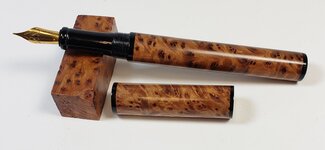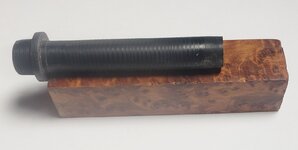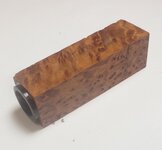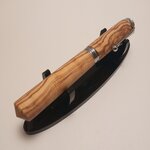Not sure you got one point of what I said: the wood moves, but what makes it crack is often the sleeve, be it metal (moving too, but differently: if the weather is hot and dry, metal will expand and wood will retract, crack! I guess most of the kit makers who used snakewood agree) or plastic (not moving, so if the wood retracts, crack again! )
If the pen is sleeveless it will be free to move, and than has less chance to crack. When turned along the grain, it will not be fragile until you walk on it. Remember recorders, bassons, clarinets and hoboes are made of wood, have a hard time with the player blowing warm wet air in it all the time and they are not prone to crack...
As for threading pens, the best results I got is using a 1 mm pitch (single or double thread) cut with a router running very fast (mine is set on 10 000 rpm); taps work honestly (a good thing for threading the section to receive the nib unit...), but not the dies - except in diameters larger than any pen. The male-female tolerance has to be comfortable to allow a certain change in geometry, so the barrel may wobble a bit in the cap when not completely screwed, this is why a good abutment is important to close them tightly.
As for species, very hard and fine-grained woods usually thread like a charm: boxwood, African blackwood, beefwood, lilac, dogwood are my first choice, threads look like been cut in metal. Most rosewoods, some fruit woods, and many other quite hard woods are not bad. Some hard woods are a bit brittle and thread a bit less perfectly, like snakewood, others have large pores (some rosewoods for instance) that do not help. But the threads are still good. The softer the wood, the crunchier the threads are, results are better if some thin CA is liberally poured before threading, but I do not have a total confidence in CA, so I cannot say anything on the long term.
Most music instruments are soaked in almond oil, so whatever the wood is, I soak my pens one day or more in linseed oil thinned with turpentine, it helps them not to move too much - or too quickly - when the weather gets drier. Or so I think...
This is what works for me.
The wood has some drawbacks though. The nib dries quickly in the cap (I put some varnish inside the cap), and the section is easily stained with ink (I only warn the customer... Some of them ask for an ebonite section to avoid ink marks).
One of the best woods for threading in my opinion, lignum vitae:
View attachment 340897




